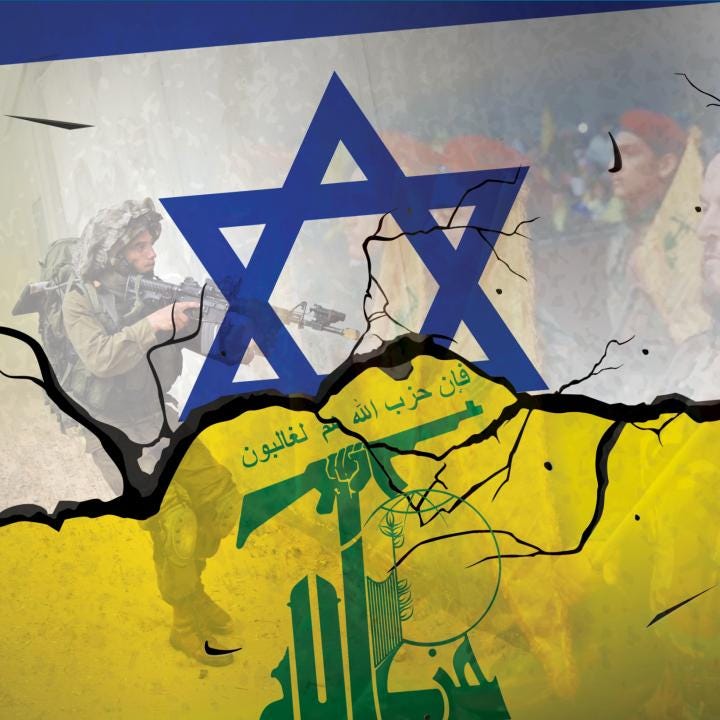BTL Roundup: The Rising Threat of War between Israel and Hezbollah
Tensions between Israel and Hezbollah continue to mount. Here's a summary of what you need to know.
Today’s podcast is delayed, but I wanted to talk about the rising tensions between Israel and Hezbollah. Although Hezbollah is a designated terrorist group, it is so much more in the sense that it possesses an arsenal that even Israeli commentators claim is more powerful than 95% of the world’s militaries. In addition to Iranian patronage, the group operates a vast multi-billion dollar criminal syndicate that is global in scope. If Israel opens up a second front to its current war, the whole world could feel the results.
Preston, myself, and the rest of the team at Between the Lines are watching this story closely and have written several articles on the subject, the links to which are below. We’ve done a lot of coverage of this possibility over the past few months, and these articles provide a lot of background and coverage you aren’t likely to see all in one place.
Here are a few quick facts on Hezbollah:
Hezbollah maintains a vast arsenal of munitions, some with a range of up to 300km, putting them within strike distance of major Israeli cities such as Tel Aviv and Haifa.
Nobody knows the exact number of munitions Hezbollah possesses, with conservative estimates claiming 120,000 and one Iranian official claiming over a million in a recent meeting.
Reports indicate Hezbollah can fire over 4,000 munitions in a single day, likely enough to overwhelm Israel’s air defense capabilities.
The two governates of southern Lebanon, where Hezbollah bases its operations, are roughly six times the size of Gaza, with rugged, mountainous terrain that, like Gaza, contains a vast amount of underground facilities. Hezbollah also maintains a substantial base of operations in neighboring Syria.
Although most of Hezbollah’s rockets are short-range, its medium- and long-range munitions pose a serious threat to Israel, especially should it overwhelm Israel’s air defenses. Image source
Regional and global ramifications
An all-out war between Israel and Hezbollah would almost certainly have broad regional and global implications. Hezbollah has already threatened to strike Cyprus, a European Union member state in the Eastern Mediterranean that the group claims could serve as a staging group for Israeli aircraft. Iran is also warning of an ‘obliterating war’ should Israel launch a full-scale war against Hezbollah. The Iran-backed Houthis have significantly impacted Red Sea shipping in recent months, and a recent rise in Houthi activity there shows they maintain the capacity to fight on. Should a regional war escalate to the point that Iran closes the Persian Gulf via the Straits of Hormuz, global energy prices would immediately spike.
With the global economy on shaky ground, the ramifications of such a war could prove disastrous to global stability. China relies most heavily on Gulf energy shipments and is currently undergoing a profound economic and debt crisis: a spike in energy prices could prove disastrous to its current situation. Moreover, the European Union is more reliant on Gulf energy than ever before, thanks to Russia’s 2022 invasion of Ukraine, and the economies of several of its member states remain in austerity and COVID-related turmoil. With recent EU elections delivering an onslaught of Eurosceptic party wins, a sudden spike in energy prices could further jeopardize the bloc as member states seek to cut their own deals to further their energy security needs. The impact of a sudden spike in energy prices on poorer, less developed countries could be even more disastrous, especially with food prices already high due to inflation and the ongoing war in Ukraine.
The spectre of US involvement
The possibility of US involvement in a broad Middle Eastern war also looms large. Should Washington become directly involved, it will be forced to counter Iran’s anti-access area denial (A2AD) strategy that, as the name implies, could limit the movement of American military assets throughout much of the region. Hezbollah and the Houthis are part of this strategy, and they, along with other proxies operating in places such as Syria and Iraq, pose a significant threat due to the ongoing proliferation of cheap Iranian weapons exports that allow them to strike targets hundreds of kilometers away. Although AI drone technology potentially offers a means to address the vast proliferation of Iranian-made munitions, it remains under development for the time being.
Check out our previous articles
We at Between the Lines are committed to providing updates as this story unfolds. Please see the links to our previous articles below for our full depth of coverage.
Israel-Hezbollah Tensions
Hezbollah’s illicit financial schemes and overseas operations
https://prestonstewart.substack.com/p/funding-a-war-chest-hezbollahs-strategic
https://prestonstewart.substack.com/p/close-to-home-hezbollah-in-latin
Iran’s Counterattack on Israel
Iranian Proxies and Sectarianism
Iranian weapons and their impact
The Houthis and the Red Sea
Stay tuned for our podcast later this week!




